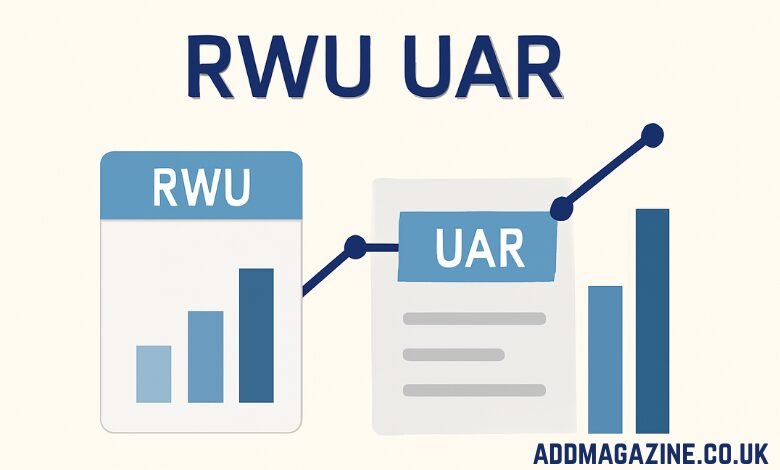The term RWU UAR is not widely known or discussed in mainstream literature, but it can be understood within specific technical, financial, or business contexts. To understand RWU UAR, we must first break it down and understand each component and its relevance. In this article, we will go through the key elements and offer a comprehensive explanation about RWU UAR, its concepts, applications, and impact.
Understanding RWU UAR: An Overview
Before diving into the complexities of RWU UAR, it is crucial to understand the terms involved. In different industries, the acronym RWU and UAR could carry different meanings. To clarify this concept, we will need to explore the individual meanings of RWU and UAR, and how they interact in certain fields.
- RWU (Revenue Unit):
- In the context of business, especially in industries like telecom, software, and hospitality, RWU stands for Revenue Unit. A Revenue Unit is a metric used to measure a specific amount of revenue generated by a product, service, or business activity. For instance, in telecommunications, it could refer to each individual customer or each subscription unit.
- The Revenue Unit is often used to track performance and growth by measuring revenue on a per-unit basis. It helps businesses identify how much money they are making per customer or service and helps in making strategic decisions about pricing, product offerings, and marketing strategies.
- UAR (User Activity Report):
- UAR stands for User Activity Report and is used primarily in the tech industry. A User Activity Report is an in-depth analysis of a user’s activity within a platform or application. It includes detailed data about the actions taken by the user, such as logins, searches, clicks, and content interactions.
- In many cases, UAR is used by companies to track user engagement and to optimize their services based on how users interact with their platform. This is essential for companies aiming to improve customer experience, retention rates, and overall performance.
Now, when these two terms come together as RWU UAR, it signifies an integrated concept where a business is closely monitoring revenue generation linked with user activity. It’s the process of analyzing Revenue Units while simultaneously tracking the User Activity Report, enabling businesses to align their strategies based on user behavior and revenue generation.
The Interplay Between RWU and UAR
The combination of RWU and UAR helps businesses optimize their revenue-generation strategies and improve user engagement. Here’s how the two concepts come together:
- Performance Metrics: By evaluating RWU and UAR together, companies can understand which specific user activities are driving revenue. For example, if certain user actions lead to a high number of subscriptions or purchases, those actions can be identified and further enhanced to increase revenue.
- Optimizing Customer Experience: Understanding how users interact with a platform through UAR allows businesses to tailor their offerings. By aligning these insights with revenue performance, businesses can personalize customer experiences that directly lead to higher revenue per user.
- Identifying Profitability: The integration of RWU with UAR provides an opportunity for businesses to determine the profitability of different customer segments. If certain groups of users are generating more revenue than others, this data can guide marketing campaigns and product offerings toward those segments.
- Behavioral Insights: By monitoring user activities over time, businesses can detect patterns that drive revenue. For example, in a subscription-based model, tracking which activities or features lead to renewals and upgrades can help optimize the platform’s offerings, thus boosting the average revenue per user.
Applications of RWU UAR in Different Industries
RWU UAR is applied across various industries, especially those that rely on user engagement and consistent revenue generation. Some notable sectors where this concept plays a vital role include:
- Telecommunications:
- In telecommunications, RWU UAR could be used to track how user activity (such as data usage or call minutes) directly translates to revenue. By analyzing UAR, telecom companies can identify which services are generating the most revenue and adjust pricing or offerings accordingly.
- For example, an increase in data usage per user could signal a need for more data plans, and a detailed UAR could help pinpoint which users are consuming the most data, allowing for targeted marketing.
- Software-as-a-Service (SaaS):
- In the SaaS industry, the RWU UAR concept is valuable because it helps businesses determine the relationship between how users engage with a service and how much they are willing to pay. By tracking activities such as the number of features used, time spent on the platform, and frequency of logins, businesses can identify the most profitable users and understand the activities that drive customer retention and upgrades.
- For instance, a company could find that users who frequently access advanced features are more likely to subscribe to higher-tier plans. This data could help in refining pricing strategies and product offerings.
- E-commerce:
- RWU UAR plays an important role in e-commerce by helping businesses understand the customer journey. A detailed User Activity Report can show the actions leading up to a sale, such as browsing behavior, product views, cart additions, and checkouts.
- By integrating RWU with UAR, e-commerce platforms can identify which activities are most closely correlated with conversions and which segments of customers are more likely to make a purchase, leading to targeted promotions and campaigns.
- Online Media and Streaming:
- Streaming services often rely on RWU to measure their success by the number of subscriptions or views. By combining RWU with UAR, these platforms can analyze how long users are spending on the platform, which content is most popular, and what drives subscription renewals.
- For example, a User Activity Report could show that users who watch content related to a specific genre are more likely to subscribe. In turn, this data could help the platform acquire more content in that genre to drive revenue growth.
- Retail:
- In the retail industry, especially with the advent of online shopping, RWU UAR can be a game-changer. By analyzing how users interact with online stores—such as browsing products, adding items to the cart, and checking out—retailers can tailor marketing efforts to boost revenue.
- For instance, a retailer might find that users who engage with product reviews are more likely to purchase. This data allows the retailer to encourage user-generated content, reviews, and ratings, thus boosting revenue.
The Role of Data Analytics in RWU UAR
Data analytics is the backbone of RWU UAR. It is through data analysis that businesses are able to draw meaningful insights from User Activity Reports and Revenue Units. Advanced analytics tools can process large volumes of user activity data and revenue metrics, providing businesses with real-time insights and forecasting future trends.
- Predictive Analytics: By leveraging historical data on user activities and revenue, businesses can predict future trends and behavior. For example, if a user consistently engages with premium content or services, predictive models can forecast that the user will likely upgrade to a paid plan.
- Customer Segmentation: Data analytics helps businesses segment their customers based on behavior and revenue potential. Understanding different customer groups’ activity and revenue allows businesses to tailor marketing efforts and optimize product development.
- Conversion Rate Optimization: With detailed UAR, businesses can identify areas where users drop off in the sales process and implement strategies to improve conversion rates. Whether it’s through simplifying the checkout process or offering targeted promotions, optimizing the conversion funnel is essential to improving RWU.
Challenges and Considerations in Implementing RWU UAR
While the concept of RWU UAR can provide valuable insights, its implementation is not without challenges. Some of the key considerations include:
- Data Privacy:
- Tracking user activities must be done in compliance with data privacy laws, such as GDPR in Europe or CCPA in California. Businesses need to ensure that user data is collected ethically and securely, and that users are informed about the data being collected.
- Data Integration:
- Businesses often use multiple tools to track user activity and revenue. Integrating these data sources can be complex, and errors in data integration can lead to inaccurate conclusions. Having a unified platform for tracking RWU and UAR is critical for ensuring the accuracy of insights.
- Real-Time Analytics:
- To get the most value from RWU UAR, businesses need access to real-time data. Delays in processing user activity or revenue data can reduce the ability to make timely decisions. Real-time analytics platforms are essential for businesses that want to stay ahead in a fast-paced market.
Conclusion
RWU UAR is a powerful concept that helps businesses understand the connection between user activities and revenue generation. By analyzing user behavior alongside revenue performance, businesses can make data-driven decisions that improve user engagement, optimize pricing strategies, and drive long-term growth. Whether in telecommunications, SaaS, e-commerce, or retail, integrating RWU and UAR can lead to better insights and improved business outcomes.
However, implementing RWU UAR requires careful attention to data privacy, integration, and analytics tools to ensure the data is accurate, actionable, and in compliance with regulations. For businesses ready to take full advantage of these insights, RWU UAR can be the key to unlocking higher profitability and sustained success.



